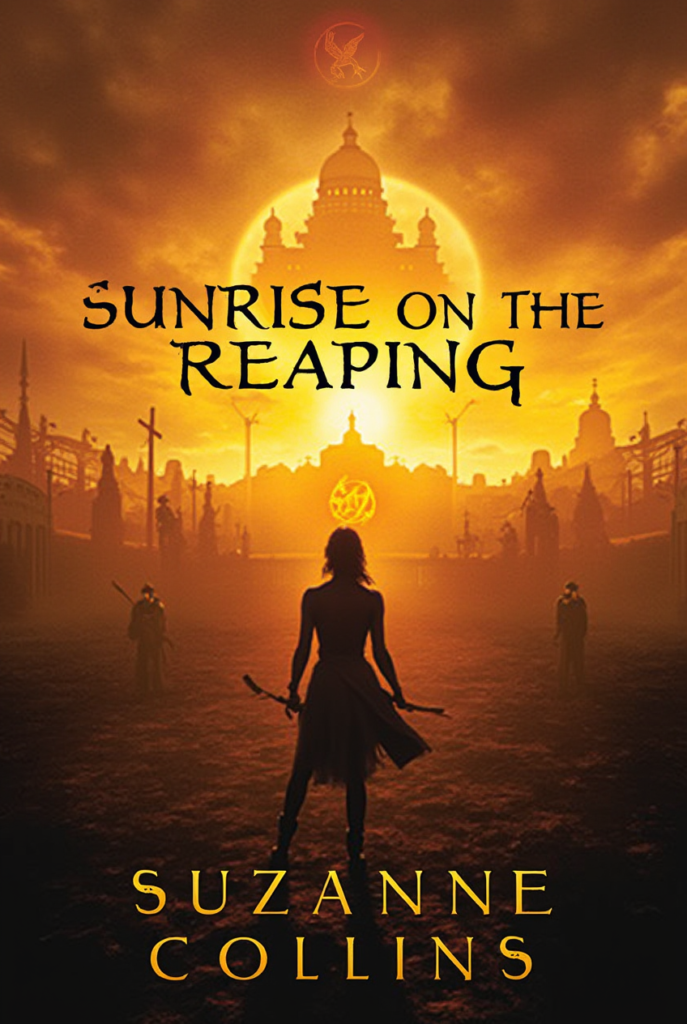Sunrise on the Reaping: Unveiling the Symbolism in Suzanne Collins’ Masterpiece

In The Hunger Games, Suzanne Collins creates a world where the boundaries between hope and despair are blurred, and each day carries the weight of survival. The “Sunrise on the Reaping” scene is a crucial moment that introduces a blend of beauty and dread, a theme that runs throughout the series. As the sun rises, the world of Panem is painted with the first light of a new day, but for its citizens, especially Katniss Everdeen, it marks the beginning of an unavoidable cycle of fear, loss, and sacrifice. But what exactly does this sunrise represent? How does it connect to the deeper themes of control, power, and survival in The Hunger Games?
In this article, you’ll explore how Suzanne Collins masterfully uses the sunrise on the Reaping to symbolize both the hope of a new day and the darkness that looms over the characters’ lives. You’ll gain insights into the emotional depth of the scene, learn how it contributes to character development, and understand how the Reaping ceremony connects to larger themes of oppression and survival. So, let’s dive into the intricate layers of this unforgettable moment.
Table of Contents
Understanding the Symbolism of Sunrise on the Reaping
The Dual Nature of Sunrise in The Hunger Games
When you think of a sunrise, you probably imagine something beautiful—gentle rays breaking through the darkness, signaling the start of a new day. In most stories, the sunrise is a symbol of hope, renewal, and opportunity. But in The Hunger Games, the rising sun takes on a much darker meaning, especially when viewed through the lens of the Reaping.
1. The Rising Sun as a Metaphor for Hope and Oppression
The sunrise in The Hunger Games represents both the promise of a new day and the oppressive reality of Panem. For the people living in the districts, the sun rising doesn’t bring the usual sense of possibility—it instead marks the beginning of another day spent under the Capitol’s control. It’s a daily reminder of their powerlessness.
- Hope fleetingly appears: The first light of the day might give the illusion of hope, but for the people of Panem, it’s just the start of another day filled with suffering. They’re bound to the Capitol’s whims, unable to escape their fate, and the sunrise serves as a poignant reminder of that.
- A cycle of oppression: Every sunrise brings with it the fear that someone you love could be chosen in the Reaping, that you might have to face the terror of the arena. The Reaping’s cyclical nature is a grim reminder that no one is truly free in Panem.
2. The Contrast Between Daybreak and the Destructive Ritual
The sunrise, symbolizing the start of a new day, stands in stark contrast to the brutal Reaping ceremony that follows it. This juxtaposition emphasizes the harsh realities the characters face, especially Katniss.
- Beauty overshadowed by fear: As the sun rises, there’s a brief moment of peace and beauty—before the Capitol’s soldiers arrive to begin the Reaping, taking away the illusion of safety.
- The Reaping as a destructive ritual: The Reaping isn’t just a lottery. It’s a violent, oppressive ritual that strips away the humanity of the districts, forcing families to sacrifice their children for the Capitol’s amusement.
Through this contrast, Suzanne Collins sets the emotional tone for the entire series: a world where beauty and cruelty coexist, where survival depends on your ability to endure.
The Reaping: A Ceremony of Fate
The Importance of the Reaping in The Hunger Games
At the heart of The Hunger Games lies the Reaping, a cruel lottery that determines which children will be sent to their deaths in the arena. But beyond the violence and bloodshed, the Reaping is an event deeply rooted in control and fear. It’s designed to maintain the Capitol’s power and remind the districts of their submission.
1. A Ritual of Control and Sacrifice
For you, as a reader, the Reaping is a chilling reminder of how power can be used to manipulate and control people. It serves as a tool for the Capitol to maintain its dominance over the districts by instilling fear, ensuring that no one dares to defy their rule.
- Fear as a tool: The Reaping creates fear in the districts, making people believe that their loved ones could be chosen at any moment. This fear prevents rebellion and keeps the people docile.
- Sacrifice for survival: The districts are forced to offer up their children in exchange for temporary peace, making the Reaping a constant reminder that survival comes at a steep price.
2. The Role of Katniss in the Reaping
For Katniss, the Reaping is both a personal nightmare and a call to action. It’s the moment that forces her to confront the reality of her world—the brutal, unfair system that has taken so much from her.
- Katniss’ personal connection: Katniss’ first reaction to the Reaping is one of fear, as it threatens her family’s survival. But when her sister Prim is chosen, Katniss’ courage emerges. She volunteers in Prim’s place, defying the system and making a selfless sacrifice.
- Symbol of transformation: The sunrise that precedes the Reaping symbolizes the beginning of Katniss’ transformation from a frightened girl into a determined fighter who will do anything to protect those she loves.
The Reaping represents a turning point not just in Katniss’ life, but in the lives of all the citizens of Panem. It’s a powerful symbol of both control and resistance.
Sunrise and the Emotional Journey of the Characters
How the Reaping Affects Katniss Everdeen
The moment of the Reaping is a life-changing event for Katniss, one that shapes her identity and her journey throughout the series. As you dive deeper into her emotions, you’ll understand just how pivotal this event is.
1. A Personal Loss
For Katniss, the Reaping is more than a simple lottery. It’s a traumatic reminder that survival in Panem is a constant battle, where losing a loved one is just part of the price of living. When Prim is selected, Katniss is faced with the reality that she could lose her sister, the one person she cares about most.
- Katniss’ fear and dread: As the Reaping begins, Katniss experiences a mix of anxiety, helplessness, and sorrow. The sunrise that marks the day only highlights the sense of doom hanging over her family.
- The decision to volunteer: When Prim is chosen, Katniss volunteers to take her place. This moment is a defining act of courage that sets the tone for her character arc throughout the series.
2. Sunrise as a Symbol of Katniss’ Transformation
The sunrise also marks a turning point in Katniss’ development. It’s the start of a new day, but for her, it’s also the beginning of a long and difficult journey—a journey that will see her transform from a scared girl into the face of resistance.
- A new beginning: The sunrise represents the start of a new chapter in Katniss’ life, one that will see her grow, adapt, and fight for survival. It mirrors the internal changes she undergoes in the face of overwhelming odds.
The Reaping’s Impact on District 12’s People
The Reaping is not just a personal tragedy for Katniss—it’s a collective experience for the people of District 12. For them, the sunrise that heralds the Reaping represents yet another day in a life of survival under constant fear.
1. A Shared Fear Among the Districts
Across the districts, the Reaping creates a sense of shared anxiety. The people of District 12 are united in their dread, knowing that at any moment, their children could be selected.
- The communal anxiety: The people of District 12 wait in silence as the names are called. There’s an unspoken bond between them, as they all share the same fear and helplessness.
- Connection to Katniss: Katniss is not just fighting for herself—she’s fighting for her entire district. Her selfless act of volunteering is a symbol of the collective spirit that exists among the districts.
Literary Techniques Used by Suzanne Collins in Sunrise on the Reaping
The Use of Imagery and Symbolism in the Reaping
Collins’ writing is rich with imagery and symbolism, especially in the scenes surrounding the Reaping. The use of light and dark, in particular, plays a crucial role in amplifying the emotional impact of the story.
1. Light vs. Dark: Daybreak and Despair
The imagery of the sunrise contrasts with the darkness of the Capitol’s power. The light of the sun symbolizes hope, but the Reaping darkens that hope, transforming it into something cold and foreboding.
- The beauty of dawn overshadowed by dread: The rising sun is beautiful, yet it’s tainted by the grim reality of the Reaping. The Capitol’s control casts a shadow over what should be a hopeful moment.
2. The Emotional Weight of Silence
Before the Reaping ceremony begins, there’s an eerie silence that hangs in the air. This silence is full of tension, symbolizing the emotional weight of what’s to come.
- Building tension: The quiet before the storm mirrors Katniss’ internal turmoil as she faces the Reaping. It’s a moment of pure emotional build-up before the chaos of the selection begins.
Conclusion: The Lasting Impact of Sunrise on the Reaping
The sunrise on the Reaping is a potent symbol in The Hunger Games, representing both the hope of a new day and the darkness that governs the world of Panem. It underscores the themes of survival, oppression, and sacrifice, reminding readers of the delicate balance between light and darkness. As you reflect on Katniss’ journey, it’s clear that this moment marks the beginning of something much larger than just the Reaping—it signals the start of a fight against an oppressive regime.
The symbolism of the sunrise and the Reaping continues to resonate throughout the series, reminding us that hope and fear often coexist, and that survival comes at a high cost.
FAQ
What is the significance of the sunrise in The Hunger Games Reaping scene?
The sunrise symbolizes both hope and despair. While it marks the beginning of a new day, it also represents the oppression and fear that the districts face under the Capitol’s rule. The sunrise serves as a metaphor for the fleeting hope that is quickly overshadowed by the brutal reality of the Reaping.
How does Katniss react to the Reaping, and how does the sunrise imagery relate to her feelings?
Katniss experiences fear, dread, and helplessness as the Reaping begins. The sunrise represents the fleeting moments of peace before the terrifying reality of the Capitol’s control sets in. Katniss’ decision to volunteer in place of her sister symbolizes her transformation from a frightened girl to a brave fighter.
What role does the Capitol play in the Reaping, and how does sunrise symbolize this power?
The Capitol uses the Reaping as a tool to maintain control and instill fear. The sunrise, representing the start of a new day, contrasts with the dark reality of the Capitol’s oppressive power, highlighting the stark divide between hope and tyranny.
How does the sunrise on the Reaping reflect the theme of sacrifice in The Hunger Games?
The sunrise marks the beginning of another day of survival under the Capitol’s oppressive rule. The characters, particularly Katniss, are forced to make sacrifices for survival, and the sunrise serves as a reminder of the sacrifices required to endure under such a brutal system.
By exploring the symbolism of the sunrise on the Reaping, you can see how Suzanne Collins’ imagery ties into the emotional and thematic depths of The Hunger Games. The dawn of each new day represents both hope and the harshness of the world, driving home the central struggles of the characters and their fight for survival.

